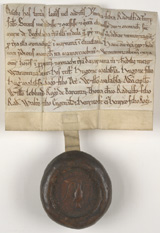 |
 |
 |
 |
 |
 |
 |
|
Byland Abbey: History
Byland Abbey: Buildings
|
Challenges from within: Furness, Calder and Byland's independence At the beginning of his abbacy Roger had to contend with problems relating to Byland’s rather ambiguous constitutional status. Furness had arguably renounced any claim to authority which it had over the community in 1138, when it turned away Abbot Gerold and his band of monks who had fled from Calder, and reclaimed their site in Cumberland. Yet, this assertion of independence was shaky and with the refoundation of Calder (Calder II) the situation grew increasingly complex since Abbot Hardrad of Calder could, in theory, claim authority over Byland. In 1149/50 Hardrad claimed Byland as a daughter-house. It seems that this assertion of power was essentially for economic reasons, as Calder was at this time facing financial hardships and probably hoped to benefit from Byland’s success. The matter was resolved when Abbot Serlo of Savigny visited England and Calder was effectively bought off. In return for eight oxen, six cows with their calves, five mares with their foals, one palfrey and a full set of priestly garments, Calder agreed to back down and to support Byland in any future dispute with Furness.(30) This checklist of gifts significantly duplicates and expands upon the list of resources that the original Calder community took from Furness to York in 1138, and suggests that Abbot Hardred was chiefly concerned to exact from Byland what he believed his community was entitled to receive – with interest.(31) Calder may have been appeased, but Furness remained a problem and challenged Byland’s subjection to Savigny. This initiated a dispute which was only resolved with the intervention of Aelred, abbot of Rievaulx, c. 1155. The abbot of Garendon presided over the investigation as judge and the verdict was witnessed by an impressive Cistercian gathering that included the abbots of Fountains, Newminster, Louth Park, Basingwerk, Rufford, Jervaulx, Kirkstall, Meaux and Ford, Prior Thurstan of Rievaulx and three monks of the house (Maurice, Galo and Daniel), three monks of Fountains (Robert, Richard and Alan), and Alan of Revesby.(32) This was clearly regarded as an important affair. Aelred decided in favour of Byland and Savigny; interestingly, his decision was influenced, in part, by the fact that Roger de Mowbray, had made a personal visit to the Cistercian General Chapter, to assign his foundation at Byland to the abbot of Savigny. The outcome of this important delegation was copied by Abbot Philip into his history of Byland and forms the climax of the work.(33) |
